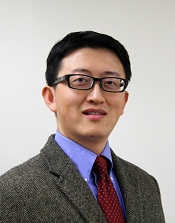报告时间:2017年5月31日上午11:00
报告地点:科技创新大楼C501室
报告题目:Ordered Intermetallic Nanoparticles for Heterogeneous Catalysis
Ordered Intermetallic Nanoparticles for Heterogeneous Catalysis
Wenyu Huang1,2,*
1Department of Chemistry, Iowa State University, Ames, Iowa 50011, United States
2Ames Laboratory, U.S. Department of Energy, Ames, Iowa 50011, United States
* Corresponding author:whuang@iastate.edu
Intermetallic compounds are special alloys that have ordered crystal structures. The formation of the ordered structure is driven by thermodynamic, which means intermetallic compounds are structurally more stable than random alloys. Intermetallic compounds have been used as heterogeneous catalysts and often lead to significantly enhanced selectivity and stability. There are more than 10,000 reported intermetallic compounds of different compositions and structures, while only a very small portion of them have been studied for application in heterogeneous catalysis. Recently, intermetallic compounds also show the promising potential to replace precious metals that are heavily used in heterogeneous catalysis. We recently discovered that intermetallic NaAu2 is catalytically active for CO oxidation at room temperature [1]. With a newly developed ship-in-a-bottle strategy [2,3], we were able to synthesize monodisperse mesoporous silica-encapsulated intermetallic nanoparticles of different compositions [4,5]. The mesoporous silica encapsulation prevents the aggregation of the intermetallic nanoparticles during high-temperature annealing that is often required for the formation of the ordered intermetallic phase. Meanwhile, the mesoporous silica shell does not prevent reactant molecules from accessing the intermetallic surface. Therefore, these mesoporous silica-encapsulated intermetallic nanoparticles provide a robust platform to study different catalytic reactions in a broad temperature regime [5].
References
(1) Xiao, C. X.; Wang, L. L.; Maligal-Ganesh, R. V.; Smetana, V.; Walen, H.; Thiel, P. A.; Miller, G. J.; Johnson, D. D.; Huang, W. Y. J. Am. Chem. Soc. 2013, 135, 9592-9595.
(2) Maligal-Ganesh, R. V.; Xiao, C.; Goh, T. W.; Wang, L.-L.; Gustafson, J.; Pei, Y.; Qi, Z.; Johnson, D. D.; Zhang, S.; Tao, F.; Huang, W. ACS Catal. 2016, 1754-1763.
(3) Pei, Y. C.; Maligal-Ganesh, R. V.; Xiao, C. X.; Goh, T. W.; Brashler, K.; Gustafson, J. A.; Huang, W. Y. Nanoscale 2015, 7, 16721-16728.
(4) Qi, Z.; Xiao, C.; Liu, C.; Goh, T. W.; Zhou, L.; Maligal-Ganesh, R. V.; Pei, Y.; Li, X.; Curtiss, L. A.; Huang, W. J. Am. Chem. Soc. 2017, 139, 4762-4768.
(5) Zhao, E. W.; Maligal-Ganesh, R.; Xiao, C.; Goh, T. W.; Qi, Z.; Pei, Y.; Hagelin-Weaver, H. E.; Huang, W.; Bowers, C. R. Angew Chem Int Ed Engl 2017, 56, 3925-3929.

Biography
Dr. Huang received a B.S. in Chemistry from Nanjing University, China in 2000. After having received an M.S. in 2002 also from Nanjing University, he started his Ph.D. research with Professor Mostafa A. El-Sayed at Georgia Institute of Technology and received his Ph.D. in 2007. Dr. Huang then began postdoctoral research with Professor Gabor A. Somorjai and Peidong Yang at University of California, Berkeley and Lawrence Berkeley National Laboratory in August 2007. He joined the faculty at Iowa State in August 2011 as an Assistant Professor and promoted to an Associate Professor in 2017.
